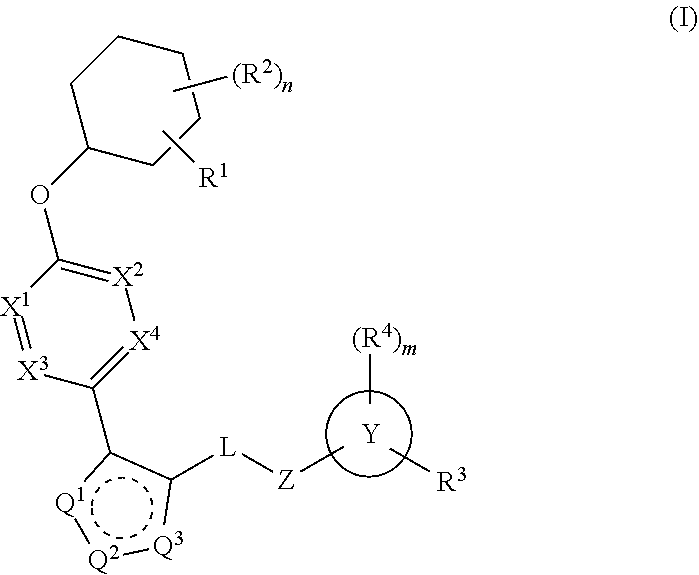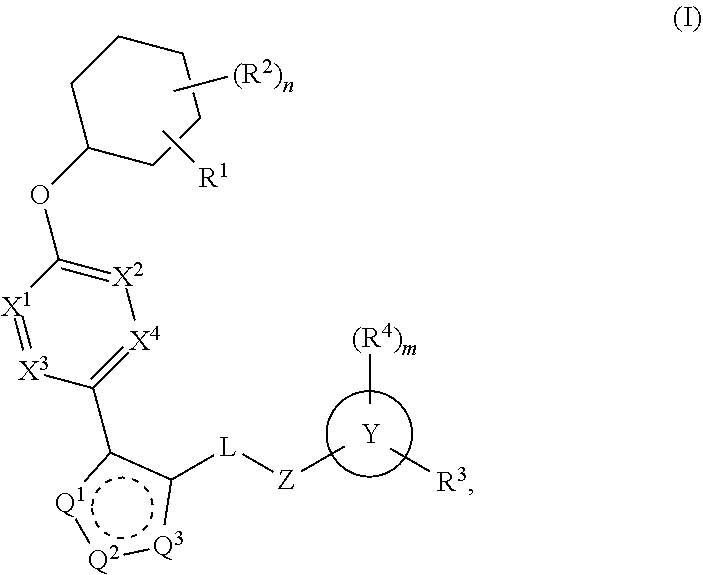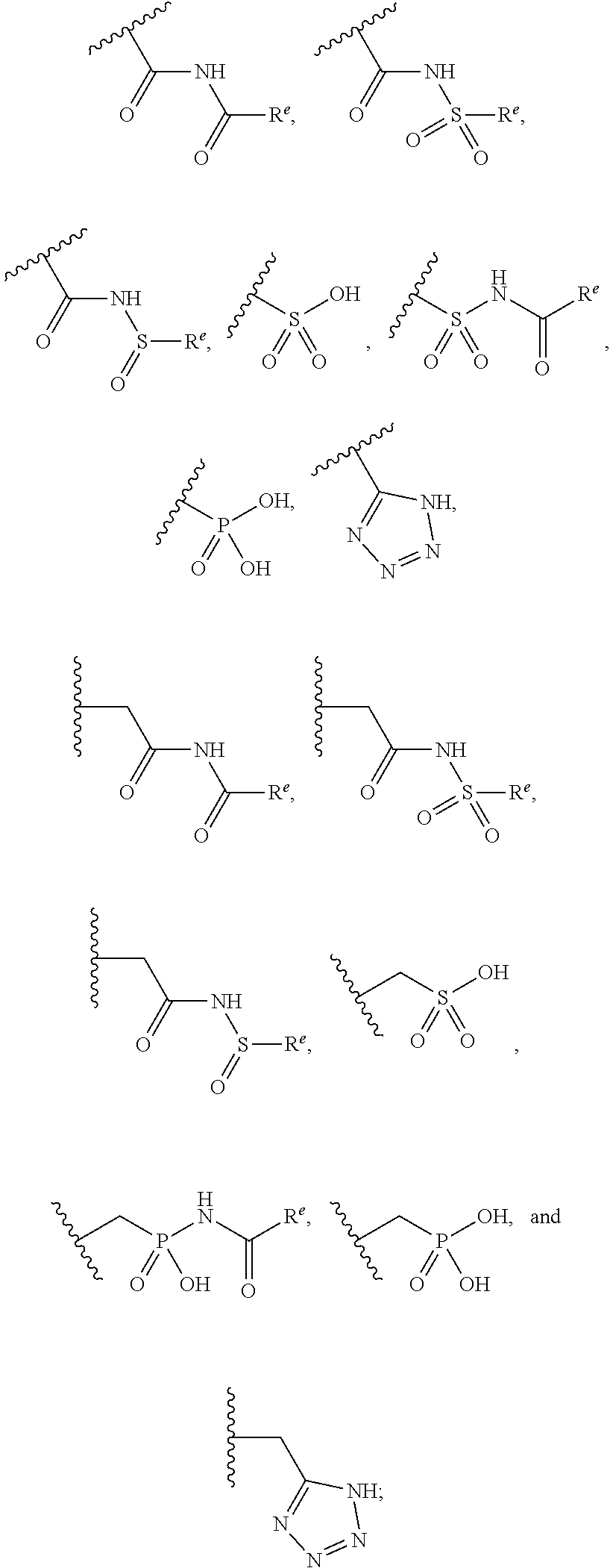Cyclohexyl acid pyrazole azoles as lpa antagonists
a technology of cyclohexyl acid pyrazole and antagonists, which is applied in the field of new drugs, can solve problems such as end-organ failur
- Summary
- Abstract
- Description
- Claims
- Application Information
AI Technical Summary
Benefits of technology
Problems solved by technology
Method used
Image
Examples
example 1
-((4-methyl-2-(1-methyl-5-(((2-phenyl-2H-1,2,3-triazol-4-yl)amino)methyl)-1H-pyrazol-4-yl)pyrimidin-5-yl)oxy)cyclohexane-1-carboxylicacid
[0548]
[0549]To a solution of Intermediate 3 (30 mg, 0.078 mmol) and 2-phenyl-2H-1,2,3-triazol-4-amine (19 mg, 0.12 mmol) in DCM (0.5 mL) was added NaBH(OAc)3 (33 mg, 0.16 mmol) and TFA (0.012 mL, 0.16 mmol) portionwise. The reaction mixture was stirred for 18 h at RT. NaBH4 (20 mg, 0.529 mmol) and MeOH (1 mL) were added and the reaction was stirred at RT for 24 h, then was concentrated in vacuo. The residue was dissolved in DCM and washed with 1N aq. NaOH and then concentrated in vacuo. The residue was stirred with 1N aq. NaOH (0.1 mL) in MeOH (1 mL) at RT for 18 h, then was concentrated in vacuo. The crude product was purified by preparative HPLC (Sunfire C18 30×100 mm column; detection at 220 nm; flow rate=40 mL / min; continuous gradient from 30% B to 100% B over 10 min+2 min hold time at 100% B, where A=90:10:0.1 H2O:MeCN:TFA and B=90:10:0.1 MeCN...
example 2
[0559]To a solution of 2D (8 mg, 0.02 mmol) in n-BuOH (0.5 mL) was added 5-chloro-3-isopropyl-1,2,4-thiadiazole (5 mg, 0.03 mmol) and iPr2NEt (11 μL, 0.06 mmol). The mixture was heated in a microwave reactor at 180° C. for 120 min, then was cooled to RT. THF (0.5 mL) / H2O (0.5 mL) / MeOH (0.5 mL) and LiOH.H2O (4 mg, 0.1 mmol) were added to the reaction mixture, which was stirred at RT overnight. Volatiles were removed in vacuo and the residue was diluted with H2O (2 mL). The mixture was adjusted with 1N aq. HCl to pH ˜5 and extracted with EtOAc (3×3 mL). The combined organic extracts were washed with brine (2 mL), dried (MgSO4) and concentrated in vacuo. The crude product was purified by preparative LC / MS: Column: XBridge C18, 200 mm×19 mm, 5-μm particles; Mobile Phase A: 5:95 MeCN:H2O with 0.1% TFA; Mobile Phase B: 95:5 MeCN:H2O with 0.1% TFA; Gradient: a 0-min hold at 24% B, 24-64% B over 20 min, then a 4-min hold at 100% B; Flow Rate: 20 mL / min; Column Temperature: 25° C. Fractions ...
example 3
[0573]A solution of (9,9-dimethyl-9H-xanthene-4,5-diyl)bis(diphenylphosphane) (5 mg, 8.0 μmol), 3F (15 mg, 0.040 mmol), 5-chloro-3-propyl-1,2,4-thiadiazole (10 mg, 0.06 mmol), BINAP (5 mg, 8.0 μmol), Pd2(dba)3 (2 mg, 4 μmol) and Cs2CO3 (20 mg, 0.06 mmol) in toluene (1 mL) was heated in a sealed tube at 110° C. overnight, then was cooled to RT and concentrated in vacuo. The residue was dissolved in THF (0.5 mL), MeOH (0.5 mL), and H2O (0.5 mL). LiOH.H2O (17 mg, 0.4 mmol) was added and the reaction was stirred at RT for 14 h, then was concentrated in vacuo. The residue was taken up in EtOAc (2 mL) / H2O (1 mL), and the solution was adjusted to pH ˜5 with 1N aq. HCl. The mixture was extracted with EtOAc (3×2 mL); the combined organic extracts were dried (MgSO4) and concentrated in vacuo. The residue was dissolved in DMF and purified via preparative LC / MS: Column: XBridge C18, 200 mm×19 mm, 5-μm particles; Mobile Phase A: 5:95 MeCN:H2O with 10 mM NH4OAc; Mobile Phase B: 95:5 MeCN:H2O with...
PUM
| Property | Measurement | Unit |
|---|---|---|
| Selectivity | aaaaa | aaaaa |
Abstract
Description
Claims
Application Information
 Login to View More
Login to View More - R&D
- Intellectual Property
- Life Sciences
- Materials
- Tech Scout
- Unparalleled Data Quality
- Higher Quality Content
- 60% Fewer Hallucinations
Browse by: Latest US Patents, China's latest patents, Technical Efficacy Thesaurus, Application Domain, Technology Topic, Popular Technical Reports.
© 2025 PatSnap. All rights reserved.Legal|Privacy policy|Modern Slavery Act Transparency Statement|Sitemap|About US| Contact US: help@patsnap.com



